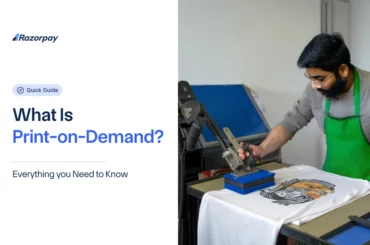As an aspiring entrepreneur, the retail business would seem fairly daunting if you have limited monetary resources, even if you are passionate and have some really strong ideas. But with the proliferation of e-commerce, the growing sophistication of technology, and smarter business models, you may be positively surprised at what you can achieve!
One such model that particularly fits the bill for you is dropshipping, a retail model that has increased rapidly over the years. According to Insight Partners, the dropshipping market was valued at US$ 162.44 billion in 2019 and is projected to reach US$ 591.77 billion by 2027, with an expected CAGR of 18.3% during the forecast period. So what exactly is this hot new trend that is blazing the retail trail? And what’s in it for you?
Take the conservative retail plunge
Dropshipping is a retail business model where the retailer takes orders from the customer for products but does not hold an inventory of those products. Instead, the retailer has a tie-up/tie-ups with a supplier/group of suppliers to procure products for order fulfillment.
These suppliers, in turn, can be manufacturers, wholesalers, or retailers themselves. Unlike traditional retail, the seller does not need to own the inventory personally and can purchase it when required from their supplier.
For entrepreneurs with fewer resources to make upfront capital investments, dropshipping is a great way to go. Instead of investing a lot of money initially, they can test out various products with low risk. Orders are placed with the suppliers only after the customer has paid, so there is no immediate compulsion to sell a backlog of products purchased.
Access suppliers at your fingertips
This online business model has been made possible with the availability of marketplace apps like Oberlo from Shopify. Through this app, one can look at various products available on AliExpress, a huge marketplace with a rich database of competitive suppliers across a wide range of products, including apparel, jewelry, home décor, and electronics.
Interestingly, while AliExpress is a large online retailer, most customers on the platform are resellers who are primarily involved in dropshipping.
Under this model, the entrepreneur sets up an e-commerce store, displays and promotes products they feel can interest customers. They set the desired markup on these products and installs a payment gateway. Once the payment is received from the customer, they will then make the order with the corresponding supplier, who will ensure the successful shipping of the product.
Lunch isn’t free but affordable!
On the other hand, one may logically wonder how such a model can work, considering how the same products are available on the marketplace itself. The primary skill that drives success is marketing. Just like a traditional retailer, you have to ensure a strong and distinctive brand positioning of your e-commerce business and build your credibility and customer reach through efficient operations and customer support.
It makes sense to pick and choose a focussed market segment initially. Ideally, the segment should be one that you are passionate and knowledgeable about, where you feel you can effectively help customers get the products they are seeking. The selection of products has to be done diligently, and in practice, you may need to experiment initially before you get the right combination.
Moreover, it is strongly recommended to avoid taking branded products from such marketplaces (unless you agree with the brand), as they may be fake/spurious, lead to a strong customer, and even legal backlash.
You need to build a brand identity, set up an e-commerce portal, and make investments in promoting it online through various digital marketing tools like social media, rich SEO-friendly content, e-mail marketing, and SEM. Richer product descriptions, and eye-catching design, for instance, can create strong competitive differentiators. So can a consistent presence on social media, where you can build an interested community of followers over time with relevant and engaging content.
Similarly, pricing has to be done strategically per your estimated business costs, expected conversion ratio, and dynamics of the market. For instance, the customer should neither feel the product is too expensive (unusually high mark-up) nor should they feel that it is inferior (extremely low mark-up). Various sales promotions like discounts and offers can also be provided from time to time to attract customers and boost sales.
Make sure that you account for shipping costs, and ideally, choose suppliers that promise free shipping. Criteria like orders fulfilled, ratings, reviews, etc., can also tell you more about the quality of the suppliers you eventually choose.
Beware of the downside
Entrepreneurs must, first of all, understand that dropshipping isn’t a ‘zero investment’ business. Your supplier side is secure, but you still have to invest in an online storefront and digital marketing to attract customers.
While dropshipping has low barriers to entry, you still have to cater to issues like product quality and returns, for which you are the front face and have to engage directly with the supplier. Another major issue that can come up is inventory.
Since you do not own it, you do not control it directly. So you must be in sync with the supplier, automatically bringing the inventory to zero or removing the product if it is not available on your portal. Shipping complications are also not in your control, and you must have a backup plan in place.
The second drawback, once again, stems from the low barrier to entry. You may expect to find many suppliers in the marketplace offering the same products. Some of them may have more financial muscle than you and would be able to offer the products at a lower mark-up. In the online world, customers are naturally tuned to choose the best deal.
As you do not control the product, you cannot do any product customization or branding. Even when a specific product starts selling well on your website, the credibility ultimately belongs to the supplier.
So you should not be complacent and build your brand over time, as discussed earlier, by ensuring that you offer the best customer experience and product assortment possible. Simultaneously, to ramp up the numbers and stay competitive, you will have to incur investments in digital marketing to build a strong and regular stream of web traffic.
Finally, your efficiency of order fulfillment and quality of customer service is critical to ensure positive word-of-mouth and repeat business. The entrepreneur has to be highly proactive to ensure that all customer complaints are efficiently and effectively addressed. One must not forget that digital channels, while extremely efficient, are two-way communication channels.
Grow your dropshipping business steadily
It is far easier for customers today to look up and ascertain the quality and credibility of your business, just like it is way simpler for them to give any feedback they want on your social media channels. It is important to grow at a pace that can be sustained, with a steady combination of new and repeat business.




![GST State Code List & Jurisdiction 2025 [Updated List] GST State Codes](https://d6xcmfyh68wv8.cloudfront.net/learn-content/uploads/2024/02/GST-State-Codes-370x245.webp)
